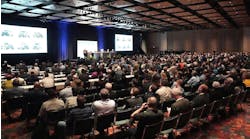[The following originally appeared in the February print edition of TBB.]
As I learned early, when an industry leader offers to chat about the market and his company, it's a good idea to take the call.
So, as a complement to TBB's annual Trailer Output Report, I'm sharing a high-level review of 2021 for the work truck equipment side of our readership. And "high-level" doesn't climb very far past John B. Poindexter, founder and longtime CEO of J.B. Poindexter & Co, corporate home to industry-leading brands such as Morgan Truck Body, Morgan Olson, Reading Truck, and Masterack, to drop a few names.
He characterized the ongoing reshaping of the JBPCO corporate structure as “centralized services” in support of “separate” business units—designed to combine the “entrepreneurial instincts” of the brands with corporate resources.
“So today we have centralized the R&D effort for electric and alternative-fuel vehicles; we’ve centralized finance, acquisition activities, procurement, lean manufacturing supervision, information technology—including the installation of a new ERP program—and partial HR,” he said. “So we're well on our way to becoming a much more unitary business than we've been in the past.”
Accordingly, a “fully functioning, first-class management team” based with the parent company—as opposed to just people handling accounting functions from HQ—is “probably the single most important change” in the business, Poindexter explained.
In turn, the company has adopted a “composite marketing tactic” in which the brands are presented to customers “on a joint basis.”
“I’ve heard the story on more than one occasion that our competitors are dumbfounded,” he said. “So many years have passed, and our company has failed to take advantage of its opportunities to cooperatively market our services and our products.”
To that end, 2021 saw the launch of JBPCO’s EAVX business unit, charged with developing next-generation delivery and work truck bodies and accessories to be integrated with electric- and alternative-powered chassis and technologies.
“While each business unit has its own R&D capability internally, EAVX will be the big brother—pulling together disparate activities into one, integrated whole that applies to all of our businesses,” Poindexter said.
And what does this “unitary” business model mean for customers?
Ultimately, it will mean lower prices, Poindexter explained—although he was quick to note that JBPCO’s brands currently come at a premium. On top of that, the cost of raw materials and labor have imposed “some very painful” price increases on customers.
“I’ll be the first admit that neither we nor anybody else have been able to do much that’s positive for customers on pricing at the present time,” he said.
So while achieving pricing advantages in the marketplace is a long-term goal, Poindexter emphasized that JBPCO has been a “consistent source of supply,” despite the constraints that hampered manufacturing throughout 2021—notably chassis supply.
“We’ve taken on an extremely serious obligation to meet the commitments we’ve made to our customers,” he said. “So the ability to actually deliver the product is a benefit in the immediate term. Then, thirdly, the customer benefits from the [JBPCO] willingness to invest—to stay at the forefront of technology for our industries.”
Among other initiatives, JBPCO has a “strong” and ongoing acquisition program, picking up a half-dozen businesses of various sizes since mid-2020—including a couple of deals in Mexico, Poindexter added.
“We feel this acquisition activity has great merit for our corporation, given our excellent financing capabilities—and, of course, our long-term outlook,” he said. “The single factor that identifies us most clearly in today's rapidly evolving market is this long-term focus. This corporation has almost never sold a business; we’re in the business of acquiring corporations in our industrial space.”
And that space—the work truck industry—is “no mystery,” he continued. So, like any other company looking to grow through acquisition, JBPCO targets “standalone” platforms, such as the 2015 purchase of Reading Truck. But currently high Price-to-Earnings ratios have made this sort of deal expensive; all of the recent JBPCO acquisitions have been “add-ons” to supplement existing brands.
But finding such deals isn’t necessarily easy.
“The artform of explaining away earnings failures has become quite well developed,” he said. “Adjusted and proforma earnings are almost works of fiction. The challenge for us is to see through the fabrications and investment memorandum, to see through the explanations of the shortfalls and determine which seem to have some merit and which do not.”
Indeed, further industry consolidation is coming, he suggested, as many smaller companies have “a very low likelihood of survival” due to the size requirements for effective supply chain management, and for attracting “first-class” management.
“Those smaller companies who will do well are those who have inspired leadership—the founder-genius who can succeed against the odds,” Poindexter said. “The middle segment of the market is going to wind up consolidated with one of the larger businesses or another: either a private equity investment firm, or an industrial company.”
But the private equity deals—typically with a five-year plan to grow earnings and resell—are “not sustainable,” he suggested. Poindexter predicted mergers will become increasingly necessary to achieve the economies of scale to compete.
So, whether you’re buying or selling, it’s time to get to know an experienced investment banker, Poindexter concluded.
And he has a track record to pay attention to.









